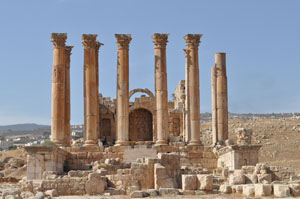Temple of Artemis at Euphesus
When the Greeks first arrive under the leadership of Androklos, Kybele (Rhea) was the major deity in all of Anatolia (the Asian part of Turkey). The Greeks introduced the worship of Artemis. Artemis and Kybele eventually became the same goddess. Artemis is the goddess of hunting, wild animals, childbirth, and nature.
According to the famous historian Strabon, the Temple of Artemis was built and destroyed seven times. It was always rebuilt on the same site. Some of the different architects were Theodoros from Samos, Chersiphon and his son Metagenes from Knossos of Crete, and Dinocrates.
The temple foundations date back to the 7th century BCE. At first, it was a small shrine to Kybele. In around 550 BCE Cretan Chersiphron, a Greek architect, designed the final temple. This initial building was sponsored by the Lydian king Croesus.
Built on the River Selinus, the building was made completely of marble except for a tile-covered wooden roof. It had 127 (some sources say 117 or 128) columns that were 20 meters high with Ionic capitals. One source says that the dimensions were 55 x 115 meters; another says the temple was 80 x 130 meters. Marble steps surrounded the temple leading to a terrace. The temple was decorated with bronze statues and other art works created by Pheidias, Polycleitus, Kresilas, Phradmon, and Praxiteles.
On July 21, 356 BCE Herostratus burned the temple to the ground. Interestingly, Alexander the Great was born on this same night. The Roman historian Plutarch wrote that Artemis was "too busy taking care of the birth of Alexander to send help to her threatened temple".
The temple was rebuilt and restored by another architect Dinocrates, who kept almost the same proportions. Supposedly, this temple lasted anywhere from 120 to 220 years. In 262 CE, the temple was finally destroyed by a Gothic fleet.
